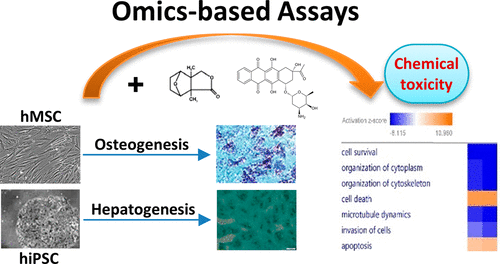当前位置:
X-MOL 学术
›
J. Proteome Res.
›
论文详情
Our official English website, www.x-mol.net, welcomes your feedback! (Note: you will need to create a separate account there.)
Omics-Based Platform for Studying Chemical Toxicity Using Stem Cells
Journal of Proteome Research ( IF 4.4 ) Pub Date : 2017-12-20 00:00:00 , DOI: 10.1021/acs.jproteome.7b00693 Yan Han 1 , Jinghua Zhao 2 , Ruili Huang 2 , Menghang Xia 2 , Daojing Wang 1
Journal of Proteome Research ( IF 4.4 ) Pub Date : 2017-12-20 00:00:00 , DOI: 10.1021/acs.jproteome.7b00693 Yan Han 1 , Jinghua Zhao 2 , Ruili Huang 2 , Menghang Xia 2 , Daojing Wang 1
Affiliation

|
The new strategy for chemical toxicity testing and modeling is to use in vitro human cell-based assays in conjunction with quantitative high-throughput screening (qHTS) technology, to identify molecular mechanisms and predict in vivo responses. Stem cells are more physiologically relevant than immortalized cell lines because of their unique proliferation and differentiation potentials. We established a robust two stem cells-two lineages assay system, encompassing human mesenchymal stem cells (hMSCs) along osteogenesis and human induced pluripotent stem cells (hiPSCs) along hepatogenesis. We performed qHTS phenotypic screening of LOPAC1280 and identified 38 preliminary hits for hMSCs. This was followed by validation of a selected number of hits and determination of their IC50 values and mechanistic studies of idarubicin and cantharidin treatments using proteomics and bioinformatics. In general, hiPSCs were more sensitive than hMSCs to chemicals, and differentiated progenies were less sensitive than their progenitors. We showed that chemical toxicity depends on both stem cell types and their differentiation stages. Proteomics identified and quantified over 3000 proteins for both stem cells. Bioinformatics identified apoptosis and G2/M as the top pathways conferring idarubicin toxicity. Our Omics-based assays of stem cells provide mechanistic insights into chemical toxicity and may help prioritize chemicals for in-depth toxicological evaluations.
中文翻译:

基于Omics的使用干细胞研究化学毒性的平台
化学毒性测试和建模的新策略是将基于人体细胞的体外测定与定量高通量筛选(qHTS)技术结合使用,以识别分子机制并预测体内反应。干细胞比永生细胞系更具生理相关性,因为它们具有独特的增殖和分化潜能。我们建立了一个强大的两个干细胞-两个谱系分析系统,包括沿成骨作用的人间充质干细胞(hMSCs)和沿肝发生的人诱导性多能干细胞(hiPSCs)。我们进行了LOPAC1280的qHTS表型筛选,并鉴定了38个针对hMSC的初步命中。接下来是对选定点击数的验证并确定其IC 50蛋白质组学和生物信息学对伊达比星和邻苯二酚治疗的价值和机理研究。通常,hiPSC比hMSC对化学物质更敏感,分化的后代比其祖细胞更不敏感。我们表明化学毒性取决于干细胞类型及其分化阶段。蛋白质组学鉴定和定量了两种干细胞的3000多种蛋白质。生物信息学确定凋亡和G2 / M是赋予伊达比星毒性的主要途径。我们基于Omics的干细胞测定提供了有关化学毒性的机械见解,并可能有助于确定化学物质的优先级,以进行深入的毒理学评估。
更新日期:2017-12-21
中文翻译:

基于Omics的使用干细胞研究化学毒性的平台
化学毒性测试和建模的新策略是将基于人体细胞的体外测定与定量高通量筛选(qHTS)技术结合使用,以识别分子机制并预测体内反应。干细胞比永生细胞系更具生理相关性,因为它们具有独特的增殖和分化潜能。我们建立了一个强大的两个干细胞-两个谱系分析系统,包括沿成骨作用的人间充质干细胞(hMSCs)和沿肝发生的人诱导性多能干细胞(hiPSCs)。我们进行了LOPAC1280的qHTS表型筛选,并鉴定了38个针对hMSC的初步命中。接下来是对选定点击数的验证并确定其IC 50蛋白质组学和生物信息学对伊达比星和邻苯二酚治疗的价值和机理研究。通常,hiPSC比hMSC对化学物质更敏感,分化的后代比其祖细胞更不敏感。我们表明化学毒性取决于干细胞类型及其分化阶段。蛋白质组学鉴定和定量了两种干细胞的3000多种蛋白质。生物信息学确定凋亡和G2 / M是赋予伊达比星毒性的主要途径。我们基于Omics的干细胞测定提供了有关化学毒性的机械见解,并可能有助于确定化学物质的优先级,以进行深入的毒理学评估。


























 京公网安备 11010802027423号
京公网安备 11010802027423号